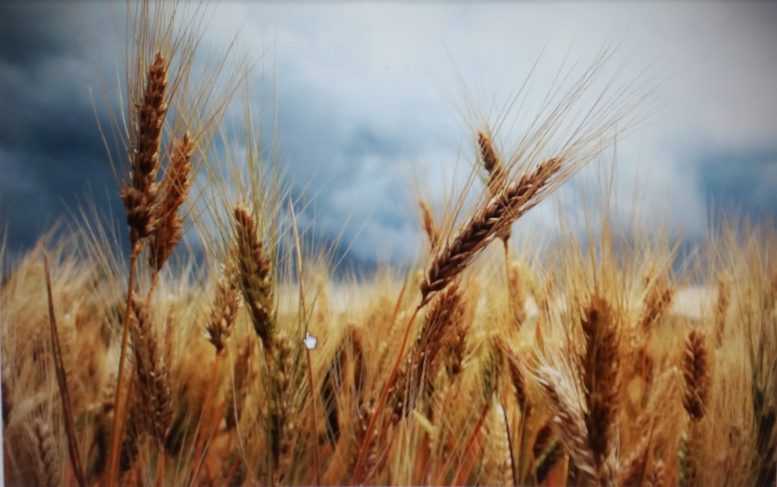By JAN LARSON McLAUGHLIN
BG Independent News
Wheat grown in Ohio is a mainstay for Oreos and Chips Ahoy. Sure, other states grow the wheat that makes artisan breads and premium pastas. But Ohio’s soft red winter wheat is the type needed for pastries, cookies, saltines, cake, brownies and pretzels.
Brad Moffitt, director of the Ohio Corn and Wheat Growers Association, talked about America’s crops in general and Ohio’s wheat in detail at a recent Bowling Green Kiwanis Club meeting.
“We are the top soft red winter wheat state,” Moffitt said. Six main types of wheat are grown in the U.S., with the differing soil types and growing seasons determining which type grows best in which areas.
Though corn and soybeans are currently more profitable, farmers realize it’s good to keep wheat in the soil rotation, Moffitt said. More than 590,000 acres in Ohio were planted in soft red winter wheat in 2016.
Moffitt described himself as “a farm boy from Urbana,” growing up with crops, cattle and hogs. He then went into a career in education, before “getting back in agriculture, where I belong.” His current job consists of working on research, market development, promotion and education.
Moffitt talked with the Kiwanians about agriculture remaining the largest industry in Ohio, and about America’s role in feeding the world.
“Our farmers are more than capable of feeding the U.S. and the world,” he said. “We’ve done it before. We’ll do it again.”
Estimates suggest that 9.7 billion people will need to be fed by the year 2050.
“American farmers have met the challenge before,” he said, describing farmers as industrious and ingenious.
The problem isn’t growing the food, Moffitt said. The real problem is transportation infrastructure, storage, refrigeration and processing.
“We can produce the food – getting it there is another problem,” he said.
The world’s demands for food have not only grown, but they also have changed. More “middle class” people means more demand for meat protein.
“They want some of the things we take for granted in this country,” Moffitt said. “When you move into the middle class, you want to eat a little bit better.”
More meat demand means more corn, wheat and soybean needed for livestock consumption, he added.
Nearly half of the wheat grown in the U.S. ends up in 125 other countries, Moffitt said. Common destinations include Mexico, South America, northern Asia, China and Europe.
“Fifty percent of the U.S. wheat crop ends up on a boat and shipped to other countries,” he said.
That keeps the ports in Toledo busy, since that is the only place in Ohio where grain can be loaded into vessels, according to Moffitt.
Farmers are not only industrious, they are also business savvy. “We are very passionate about NAFTA not being messed up,” he said.
Ohio wheat farmers know that French bread bakers could get their wheat from the Ukraine, but they prefer the quality of the soft red winter wheat grown in the U.S. That wheat is vital to French baguettes.
“I didn’t know what a baguette was until someone stuck it in my bag at Panera,” Moffitt said.
The demand for Ohio wheat in France is high.
“They still buy fresh bread every day,” he said. “The quality of the grain is very important.”
The TPP trade agreement, of which the U.S. is no longer a member, is a “hot button” issue. “The TPP would have been a godsend to American agriculture,” Moffitt said.
Here are some facts about soft red winter wheat:
- Ohio was the top U.S. producer of soft red winter wheat in 2016.
- Wheat ranks third among Ohio field crops.
- Ohio grain farmers grew 590,000 acres of soft red winter wheat in 2016.
- Ohio is known for producing the highest quality flour among the states that grow soft red winter wheat.
- The world’s largest snack companies use Ohio’s soft red winter wheat to make America’s favorite cookies, like Oreos.
- One bushel of wheat makes about 42 pounds of flour, enough to bake 5,000 4-inch cookies.
- After harvest, the remaining wheat stalks are used as straw for livestock bedding and fodder, and in landscaping.
- The wheat is used to make non-food items like trash bags, soap and concrete.
- Soft red winter wheat contains a hearty supply of vitamins B and E, iron, zinc and potassium.
- The wheat is used by vodka distilleries, such as Ohio’s award-winning Middle West Spirits.
Ohio farmers are also planting more acres in barley to sell to area craft beer breweries.
“Barley’s come back in a big way,” he said. “They need barley and they don’t want to truck it from Montana.”
There are six classes of wheat grown in the U.S., designated by color, hardness and their growing seasons.
- Hard red winter wheat is grown heavily in the middle of the nation, primarily in Kansas, Nebraska and Oklahoma. It has good milling and baking characteristics for pan bread, Asian-style noodles, hard rolls and tortillas.
- Hard red spring wheat is found primarily in North Dakota, South Dakota and Montana. It is considered the “aristocrat” of wheat when it comes to “designer” foods like hearth breads, rolls, croissants, bagels and pizza crust.
- Soft red winter wheat is grown throughout the states bordering the Mississippi River, the southeastern coastal states, and with the heaviest grouping in Northwest Ohio. It is a weak-gluten wheat often used for cookies, crackers, pretzels, pastries and flat breads.
- Soft white wheat is found in Washington, Oregon and Idaho. It offers a whiter product for exquisite cakes, pastries and Asian-style noodles.
- Hard white wheat is scattered throughout the Kansas area and California. It is used for Asian-style noodles, whole wheat white flour, tortillas, pan and flat breads. As the newest class of U.S., exportable supplies are limited.
- Duram wheat is found primarily in North Dakota, Montana and California. It is the hardest of all wheats, has a rich amber color and high protein content ideal for premium pastas, couscous and some Mediterranean breads.





